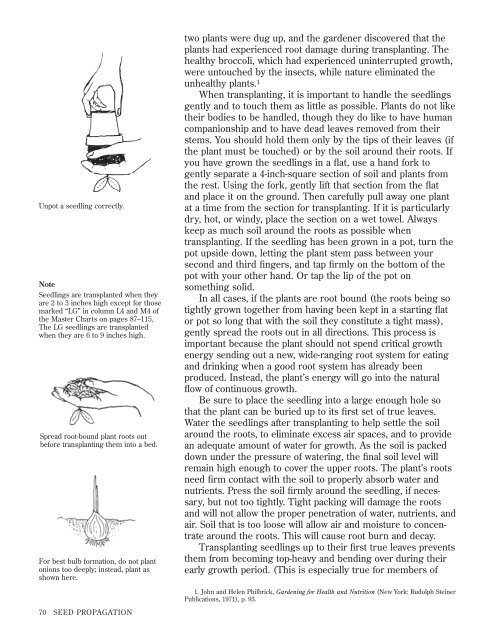How to Grow More Vegetables : And Fruits, Nuts ... - Shroomery
How to Grow More Vegetables : And Fruits, Nuts ... - Shroomery
How to Grow More Vegetables : And Fruits, Nuts ... - Shroomery
Create successful ePaper yourself
Turn your PDF publications into a flip-book with our unique Google optimized e-Paper software.
Unpot a seedling correctly.<br />
Note<br />
Seedlings are transplanted when they<br />
are 2 <strong>to</strong> 3 inches high except for those<br />
marked “LG” in column L4 and M4 of<br />
the Master Charts on pages 87–115.<br />
The LG seedlings are transplanted<br />
when they are 6 <strong>to</strong> 9 inches high.<br />
Spread root-bound plant roots out<br />
before transplanting them in<strong>to</strong> a bed.<br />
For best bulb formation, do not plant<br />
onions <strong>to</strong>o deeply; instead, plant as<br />
shown here.<br />
70 SEED PROPAGATION<br />
two plants were dug up, and the gardener discovered that the<br />
plants had experienced root damage during transplanting. The<br />
healthy broccoli, which had experienced uninterrupted growth,<br />
were un<strong>to</strong>uched by the insects, while nature eliminated the<br />
unhealthy plants. 1<br />
When transplanting, it is important <strong>to</strong> handle the seedlings<br />
gently and <strong>to</strong> <strong>to</strong>uch them as little as possible. Plants do not like<br />
their bodies <strong>to</strong> be handled, though they do like <strong>to</strong> have human<br />
companionship and <strong>to</strong> have dead leaves removed from their<br />
stems. You should hold them only by the tips of their leaves (if<br />
the plant must be <strong>to</strong>uched) or by the soil around their roots. If<br />
you have grown the seedlings in a flat, use a hand fork <strong>to</strong><br />
gently separate a 4-inch-square section of soil and plants from<br />
the rest. Using the fork, gently lift that section from the flat<br />
and place it on the ground. Then carefully pull away one plant<br />
at a time from the section for transplanting. If it is particularly<br />
dry, hot, or windy, place the section on a wet <strong>to</strong>wel. Always<br />
keep as much soil around the roots as possible when<br />
transplanting. If the seedling has been grown in a pot, turn the<br />
pot upside down, letting the plant stem pass between your<br />
second and third fingers, and tap firmly on the bot<strong>to</strong>m of the<br />
pot with your other hand. Or tap the lip of the pot on<br />
something solid.<br />
In all cases, if the plants are root bound (the roots being so<br />
tightly grown <strong>to</strong>gether from having been kept in a starting flat<br />
or pot so long that with the soil they constitute a tight mass),<br />
gently spread the roots out in all directions. This process is<br />
important because the plant should not spend critical growth<br />
energy sending out a new, wide-ranging root system for eating<br />
and drinking when a good root system has already been<br />
produced. Instead, the plant’s energy will go in<strong>to</strong> the natural<br />
flow of continuous growth.<br />
Be sure <strong>to</strong> place the seedling in<strong>to</strong> a large enough hole so<br />
that the plant can be buried up <strong>to</strong> its first set of true leaves.<br />
Water the seedlings after transplanting <strong>to</strong> help settle the soil<br />
around the roots, <strong>to</strong> eliminate excess air spaces, and <strong>to</strong> provide<br />
an adequate amount of water for growth. As the soil is packed<br />
down under the pressure of watering, the final soil level will<br />
remain high enough <strong>to</strong> cover the upper roots. The plant’s roots<br />
need firm contact with the soil <strong>to</strong> properly absorb water and<br />
nutrients. Press the soil firmly around the seedling, if necessary,<br />
but not <strong>to</strong>o tightly. Tight packing will damage the roots<br />
and will not allow the proper penetration of water, nutrients, and<br />
air. Soil that is <strong>to</strong>o loose will allow air and moisture <strong>to</strong> concentrate<br />
around the roots. This will cause root burn and decay.<br />
Transplanting seedlings up <strong>to</strong> their first true leaves prevents<br />
them from becoming <strong>to</strong>p-heavy and bending over during their<br />
early growth period. (This is especially true for members of<br />
1. John and Helen Philbrick, Gardening for Health and Nutrition (New York: Rudolph Steiner<br />
Publications, 1971), p. 93.












